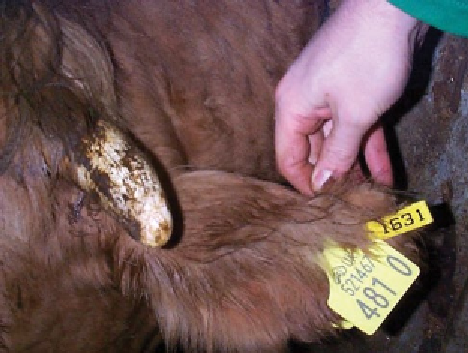Agriculture Reference
In-Depth Information
offal from officially BSE-free holdings are separated
from those of 'lower' status.
Traditional post-mortem inspection
This post-mortem inspection system described by von
Ostertag at the end of the nineteenth century was a para-
digm shift in public health control and was designed to
control the hazards known at that time. These were
primarily bovine TB and parasites. Its significance is
illustrated by the fact that it became established as the
standard to be followed worldwide and maintained
acceptance for 100 years. The basics of the observations
required, the palpations and incisions, are outlined in the
following paragraphs. The principal purpose of this
inspection protocol is to determine if the carcase and offal
are 'normal' and to separate the normal from the abnor-
mal. The lymph nodes are considered in this system to be
the sentinels for infection of the body systems, so empha-
sis is put on their size, colour and structure on incision.
Figure 9.7
Bovine ear tag, correlated with kill number ante-
mortem (Reproduced with permission from Harold Moore).
by a tattoo, or slap mark, applied ante-mortem but leg-
ible only after scalding and scraping. Grades on pigs are
frequently identified by writing on the exposed dermis
with a special wax pencil (Fig. 9.7).
Any good system of carcase meat identification must
be clearly legible, easily applied, cheap, non-toxic, non-
corrosive and suitable for use with modern data retrieval
systems. The UK Meat and Livestock Commission issued
a guide on the labelling of carcase meat and prime cuts
some years ago. It concluded:
Traditional post-mortem inspection of cattle
The traditional EU requirements for post-mortem
inspection of carcases intended for human consumption
are specified in Regulation (EC) 854/2004, Annex I.
Inspection of a carcase and its organs should proceed in
the following order although this may be enhanced if
justified by specific hazards being suspected (Fig. 9.8).
Head
An examination of the outer surfaces and eyes is followed
by an inspection of the gums, lips and tongue for foot-and-
mouth disease, necrosis and other forms of stomatitis,
actinomycosis and actinobacillosis, the tongue being
palpated from the dorsum to the tip for the latter disease.
Incisions of the internal and external masseters for
C. bovis
should be made parallel with the lower jaw.
After the tongue is dropped, routine incisions of the ret-
ropharyngeal, submaxillary and parotid lymph nodes
should be made for tuberculous lesions, abscesses and
actinobacillosis. The tonsils of cattle and pigs frequently
harbour pathogens such as tubercle bacilli,
Salmonella
and
Yersinia
. Consequently, regulations may specify that
they should be removed and should not be used as ingre-
dients of meat products. As part of the BSE controls, the
tonsils must be classified as specified risk material (SRM)
and must be removed and disposed of as such.
1
Do not label, write or stamp unless essential.
2
Fix labels in a consistent position to aid checking and
removal.
3
Do not apply labels to parts of the carcase likely to be
used for manufacturing, such as flank or brisket.
4
Remove all labels and clips as soon as they are no
longer needed.
5
On bone-in cuts, apply the label close to the bone and
to only one cut in each customer's batch.
6
Label pork carcases high on the front of the hock,
away from the ham.
7
Label lamb carcases on the front of the shank.
8
Label beef carcases on the rib cage or chine bone or
vertebral column and veal carcases on the leg.
Meat detained for re-inspection
must also be identi-
fied in a place and by a means acceptable to both the
abattoir food business operator and the official veteri-
narian. A system developed post-BSE ensured that the
inspection team were aware of the exact identity and
category of every carcase and offal passing through the
abattoir. This involved a system which could ensure that
correlation was maintained in order that specified
bovine offal was properly removed and that meat and
Lymph nodes
The detailed examination of lymph nodes, often recom-
mended in different meat inspection codes, is mainly for
the detection of TB and is fully justified where this
disease is a problem.

